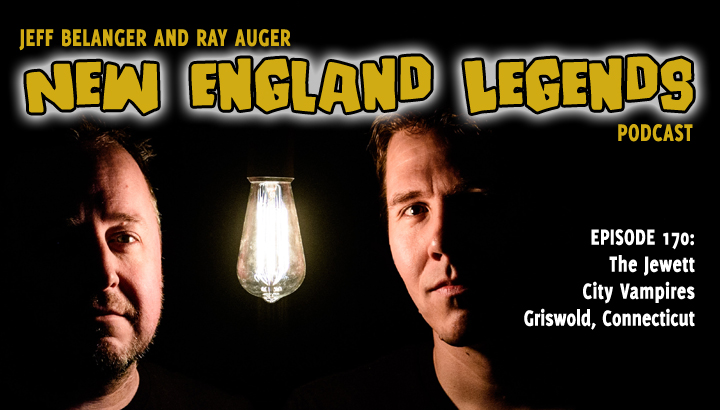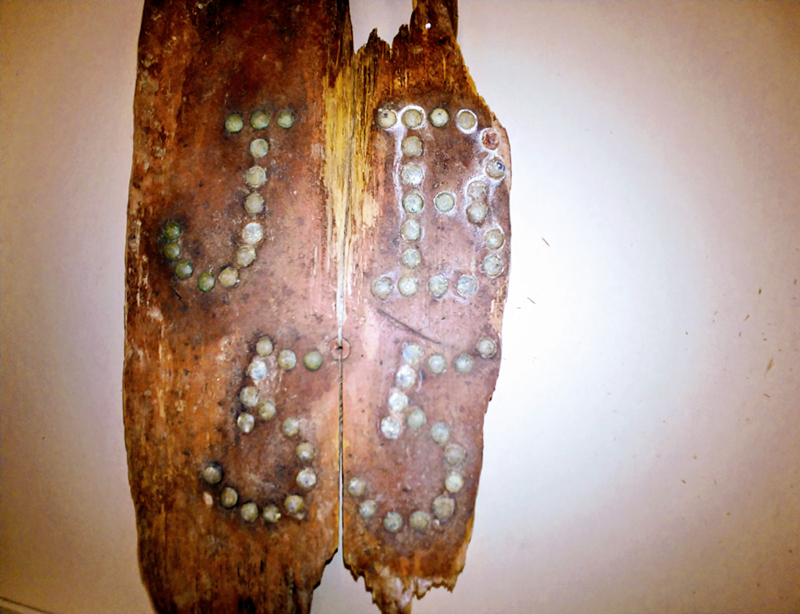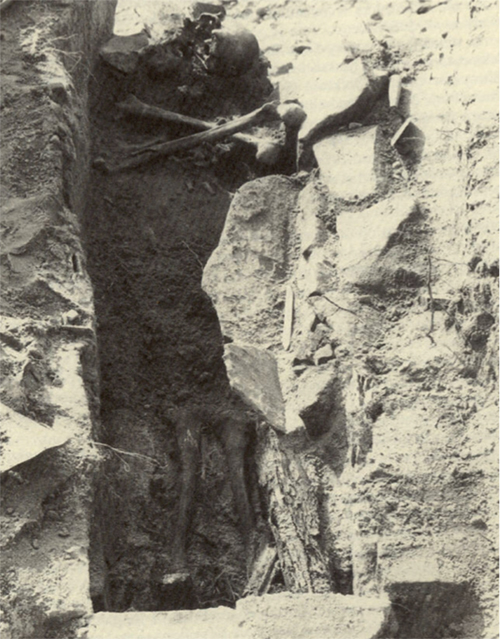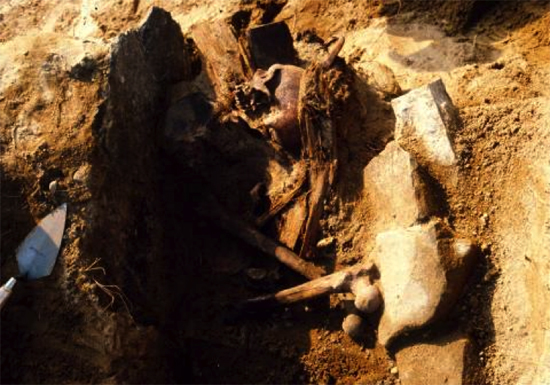

In Episode 170, Jeff Belanger and Ray Auger drive through the suburbs of Griswold, Connecticut, in search of a vampire unearthed by state archaeologist Dr. Nicholas Bellantoni back in 1990. The vampire, dubbed J.B. 55, may have been Griswold’s first vampire, but he would not be the last. As we’ve seen before, vampires show up in times of plagues. We can’t help but wonder if they’re poised to return.
CALL (OR TEXT) OUR LEGEND LINE:
(617) 444-9683 – leave us a message with a question, experience, or story you want to share!
BECOME A LEGENDARY LISTENER PATRON:
https://www.patreon.com/NewEnglandLegends
CREDITS:
Produced and hosted by: Jeff Belanger and Ray Auger
Edited by: Ray Auger
Theme Music by: John Judd
Guest: Dr. Nicholas Bellantoni
SUBSCRIBE TO THE PODCAST FOR FREE:
Apple Podcasts/iTunes | Google Podcasts | Spotify | Pandora | Stitcher | Amazon Podcasts | TuneIn | iHeartRadio | SoundCloud
JOIN OUR SUPER-SECRET:
New England Legends Facebook Group



EPISODE TRANSCRIPT:
*A note on the text: Please forgive punctuation, spelling, and grammar mistakes. Like us, the transcripts ain’t perfect.
[DRIVING IN CAR]
JEFF: Ray, how’s quarantine treating you?
RAY: I’m not sure I’ll ever get used to all of the isolation, Jeff. I miss the crowds! Concerts! Crowded parks and beaches. Bars packed with people!
JEFF: That all sounds like another world now, doesn’t it?
RAY: It does. This covid pandemic has changed everything. I’m glad we can still have our adventures, though. Often we go to some remote places where we don’t see anyone around for miles. Other times we end up in some modern subdivision neighborhood like this one in the Hopeville section of Griswold, Connecticut… But I don’t think any of these homeowners are going to let us inside.
JEFF: No, probably not. And though this neighborhood isn’t the most spooky setting we’ve ever visited, it’s what used to be here just 30 years ago, that’s the reason we’re driving through today.
RAY: What was here 30 years ago?
JEFF: Before these houses, there was a hill here, and a construction gravel pit. And one day in the late fall of 1990, two young kids were playing on the hill, and without meaning to, these boys unearthed a vampire.
[INTRO]
JEFF: I’m Jeff Belanger.
RAY: And I’m Ray Auger. Welcome to Episode 170 of the New England Legends podcast. If you give us about 10 minutes, we’ll give you something strange to talk about today. Though today we may need more than ten minutes, so please forgive us, but this story is good and needs a little extra space.
JEFF: We’re on a mission to chronicle every legend in New England one story at a time…
Ray: I am so excited today, Jeff.
Jeff: I can tell Ray. There’s a glow about you.
Ray: We’ll I’m proud to announce our brand new partnership with Nuwati Herbals. Native American inspired herbal remedies, teas, lotions, soaps and more. Products that I’m happy to be endorsing AND consuming! Here, give this Laughing Coyote cream a try…
Ray: No, no, no… that one you don’t consume. Apply that to some of your pressure points for a happier you.
Jeff: Ah, well that makes more sense. Oh, that is nice.
Ray: And there’s a Laughing Coyote tea that’s just as good… that one’s for consuming. Plus I love the name… The Coyote is known as the trickster and teaches us that laughter is the best medicine.
Jeff: People LOVE the names of Nuwati’s products. Look at all these natural ingredients… Hibiscus Flower, Green Tea, Lemon Grass, Rooibos Root, Rose Hips…
Ray: Right? So you know it’s good.
Jeff: We’re excited to introduce you to so much more that Nuwati Herbals has to offer over the next few months. In the meantime please visit nuwatiherbals.com That’s N-U-W-A-T-I herbals with an S dot com. And give them a like on Facebook. Rod and Kim are great folks and we thank them for choosing New England Legends Podcast to get the word out about their products.
RAY: And be sure to use promo code LEGENDS20 when you check out to save 20% on your order. So we’re on the trail of another vampire in New England, Jeff?
JEFF: That we are, Ray. This will make number four for us, and our first in Connecticut.
RAY: We learned in those other three cases that those vampires were tied to a plague. Is that also true in this case?
JEFF: It is. Plagues have been through our country before. They make for dark times and sometimes panic over monsters. When we’re too scared to believe our doctors and our ministers and clergy, that’s when vampires are born. To set this up, we’re going to head back to 1845.
[TRANSITION]
RAY: It’s 1845 here in eastern Connecticut along the Quinebaug River. This is very much a farming community. Working class and middle class people who work the land for their livelihood. But… there’s a plague going around the region.
JEFF: That plague is called Consumption. Once the illness sneaks its way into your lungs it eats you away from the inside. The victim goes through fever, chills, and weight loss, which may be why they call this sickness the wasting disease. Consumption can kill you in a matter of weeks, but it can also be a slow and painful death taking months or even years as it wears you down to nothing.
RAY: That plague of consumption has just arrived at the home of Lemuel Ray and his family who reside in Jewett City section of Griswold.
[MAN COUGHING]
RAY: Lemuel’s health declines quickly. His body deteriorates, and soon it’s clear he’s not going to survive this. His family try to keep him comfortable, but he soon succumbs to the illness.
[CHURCH ORGAN FUNERAL SONG]
JEFF: After Lemuel’s body is laid in the ground, his friends and neighbors go on with their lives as well all must do. (PAUSE) Two years go by, and that’s when Lemuel’s brother, Horace Ray gets ill. His symptoms are all too familiar to his family. It’s clear he too has consumption.
[MAN GROANING IN FEVER PAIN]
JEFF: Like Lemuel, Horace wastes away to almost nothing. He looks almost skeletal. Imagine walking into his bedroom in the morning to find blood on the corner of his mouth, maybe even running down his neck? And now you wonder if he’s coughing up his own blood or if maybe something sinister is feeding on him. Horace struggles…
[LABORED BREATHING]
JEFF: And then breathes his last rattling breath.
[DIGGING]
RAY: Horace Ray is laid into the ground as his family picks up the pieces of their lives once again. It’s now 1850, and two of Horace’s sons get ill with the same disease… their family and friends watch in horror as they too waste away and then die. When Horace’s third son shows signs of consumption, the family begins to wonder if they’re the victims of bad luck, or maybe there’s a monster hunting them down.
JEFF: The whole Griswold community is saddened by the misfortune of the Ray Family. And that’s when someone whispers maybe there’s something undead seeking them out. They may just be the target of a vampire. (PAUSE) Vampires show up in times of plagues like consumption. They drain the vitality and life force of the living. If you can identify the vampire and kill it, you may just save your loved ones.
RAY: The things is, vampires aren’t a new idea in Griswold. The Ray family… like pretty much everyone else in town… heard stories of a vampire in town just about 30 years earlier.
JEFF: The way you deal with a vampire is that first you must identify the monster. A vampire is the undead, and usually has a strong connection with the victim’s family. So if three or four members of your family have succumbed to consumption, you have to exhume the bodies of those who have perished and look for signs.
RAY: What kind of signs?
JEFF: If the body isn’t decomposing as it should, or if there’s liquid blood in the heart, or if the body has moved or shifted position in the grave… those could all be signs of vampirism.
RAY: Somewhere in Griswold a vampire was found before?
JEFF: Around 1820, folks dug up a body and desecrated it in a specific way in order in try to kill the undead vampire. The Ray family would have heard the stories, and that’s when they get an idea. A group of Ray family members and friends head down to the Jewett City burial ground. And they start digging.
[DIGGING]
JEFF: They exhume the bodies of the Ray brothers who passed away last year. And they see they’re not yet fully decomposed. They figure if there’s still flesh, they’re still feeding. Not willing to take any chances…
[FIRE STARTING]
JEFF: They set the corpses on fire and burn them into ashes.
RAY: The newspapers catch wind of this event, and many folks are incredulous at the news out of Jewett City.
JEFF: That they are. Ray check out this article from the May 24, 1854 Hartford Courant newspaper.
RAY: The headline reads quote “Strange superstition – Burning the Dead.” And the last line of the article reads: We seem to be transported back to the darkest age of unreasoning ignorance and blind superstition, instead of living in the middle of the 19th century, and in a state calling itself enlightened and Christian.
JEFF: Desperate times call for desperate folk remedies. The Ray family aren’t the first, nor will they be the last suspected vampires in New England.
RAY: I’m still curious about that vampire case here in Griswold from the 1820s.
JEFF: To figure that one out, we’ll have to time travel once again.
RAY: Back to 1820?
JEFF: Nope. This time we’re going to jump ahead to 1990.
[TRANSITION]
JEFF: It’s late fall of 1990 here in Griswold, Connecticut.
RAY: 1990?! As in, Ray and Jeff are still in high school right now, 1990?!
JEFF: Exactly.
RAY: I see we’re standing in front of a construction area here in the Hopeville section of Griswold. There’s a hill that’s being dug out by large earth movers and construction equipment. There’s a large pile of gravel, piles of dirt everywhere. It looks like they have about a quarter of this hill already dug out.
JEFF: The kind of place that you’d love to explore as a kid, right?
RAY: Absolutely! And considering it’s Saturday, and the equipment is shut off for the weekend, and there’s no workers around. It seems like a pretty good time to explore the place.
JEFF: Ha! I agree, but it looks like those two kids over there beat us to it.
RAY: Fair enough. Oh to be ten years old again. Check them out scrambling up that freshly-dug dirt hill.
JEFF: Oh man, the dirt’s starting to slide out beneath them.
RAY: Hey! Be careful you kids!
JEFF: I see them sliding down the dirt almost like a snow hill. Ha! They’re filthy. That’s awe… wait a minute. What are those white things rolling down behind them?
RAY: I don’t know… they almost look like…
[KIDS SCREAMING AHHHHHH!]
RAY: Dude, those look like human skulls!
JEFF: They ARE human skulls!
[POLICE SIREN]
RAY: Annnd now this is a potential crime scene. The police send the skulls to the medical examiner who quickly determines these skulls are old. This is not any kind of modern crime. The police can now see that the earth-moving equipment had cracked open a previously unknown family burial plot. So now it’s a job for state archeologists to unravel this mystery.
JEFF: Which is exactly why we’re connecting with the guy they just called. The man who came here to this gravelly hill to make a gruesome discovery.
BELLANTONI: My name is Nicholas Bellantoni. I am the emeritus Connecticut State archaeologist. I served as the state archeologist here in Connecticut for almost 30 years.
RAY: Dr. Bellantoni, what did you find when you went up that hill?
BELLANTONI: It was a whole farming family cemetery. There were 29 graves that were on the edge of that gravel bank that nobody knew was there. From what we can gather, there were no stamped markers other than flat field stone or field stones that were not engraved, so when the miners went up there to log the trees, cut the topsoil, and then start mining the subsoil for construction purposes, they had no idea that there was a cemetery up there.
JEFF: Do you know who was buried in the cemetery?
BELLANTONI: We were able to do a land deed research and found a land deed dating back to 1757 where a Nathaniel Walton had purchased the top of this land for the purposes of burying his family. So we have the Waltons involved. But it turn out, we would later find out, is that the Waltons left Griswold in the early 1800s to go and settle what was called the Western Reserve out in northeast Ohio, and when they sold their farm and abandoned it, they left their cemetery obviously.
RAY: All of this land is getting developed into subdivision housing. So these 29 graves need to be rescued and relocated. And there’s not a lot of time because these construction crews are on hold while this historic investigation is taking place.
JEFF: Dr. Bellantoni and his crew start excavating the graves located closest to the gravel bank, because those were in the greatest danger of collapsing. He explains that if you look at the hillside, it’s pretty obvious where the graves are located because you can see a shaft of darker dirt coming down from the surface.
RAY: Oh yeah, I see that!
JEFF: That’s soil that would have been mixed up after the grave was dug and then reburied.
[DIGGING]
RAY: Dr. Bellantoni and his crew are digging through the first six graves when they discover brass tacks on the lid of the coffins. Those tacks spell out initials. Look over here. There’s an N.B., and over there is an I.B., and right over here is a J.B. with the number 55 under his initials. 55 would have been his age at the time of his death.
JEFF: After removing the rotting coffin lids, Bellantoni finds intact skeletons in the first three graves. There are metal pins that held the funeral shrouds closed, but nothing else. Meaning these folks were working class. They weren’t even buried in clothes because those clothes would be needed for other family members. But then he reaches the grave of J.B. 55 and his brick-lined crypt. And that’s when he makes one of the strangest finds of his career.
BELLANTONI: When we started to excavate horizontally down from the top of the gravel bank, onto the stones arching the crypt, that’s when the first thing I noticed was that the stones on top, a couple of them had been broken and collapsed. Now I didn’t think too much of that because I thought maybe that had to do with earth pressure, you know, for one hundred, two hundred years, the earth on top of that had settled down and moved the stones. But when we first started to open the crypt, that is to say remove the field stones that were covering the coffin. I started at the foot region of the coffin, and there I could see the feet, the bones of the feet. And the tibia or shin bone, in perfect anatomical position. Nothing surprising there. But then as I moved up the grave to remove those field stones, I started to see things that I had never seen before. One of which was that the femurs or thigh bones had been dislodged from their anatomical positions, and crossed over the chest. The chest had been broken into, the arms had been moved, or rearranged a little bit, and the skull, or the head, had been deliberately decapitated and rolled to face the west. Suffice it to say I was befuddled, because I had worked on other graves in my tenure, I had never seen anything like this. I had no idea what I was looking at.
RAY: So Bellantoni takes pictures.
[SFX PHOTOS]
RAY: He’s thinking about the Jolly Roger and pirates, but realizes he’s pretty far inland for that. So that doesn’t make any sense. And then he considered maybe this was some Masonic burial ritual because they’ve used skull and crossbones as one of their symbols. But there are no other Mason indicators, so that also seems unlikely. That’s when Bellantoni spots a detail he missed before.
BELLANTONI: In the field, while examining the bones before we even removed them, I could see fractures in one of the femurs that had uprooted and crossed. The signature on that fracture suggested that whoever went into this grave, did so about four to five years after J.B. died and was buried.
JEFF: So J.B. had been in the ground for years, and then someone had a reason to dig him up and desecrate his remains. At first, Dr. Bellantoni suspects vandalism. Like a grave robber. But when he looked at the other graves, there were no jewelry or even clothing in there. So there’s nothing to steal. So that makes no sense.
BELLANTONI: As I started to communicate with my colleagues, one of them got back to me and said, “Well, have you heard the story of the Jewett City Vampire and the Ray Family?” And at that point I had not. So I did some research, and it was at that point that I had the fortune to connect with Michael Bell, a folklorist in Rhode Island, who had been studying the vampire folk belief in New England many years before I uncovered J.B.
RAY: If you’ve been listening to us for a while, then you know the name Michael Bell. He’s spoken with us about a few other legends in the past. Once Michael Bell looks at the photos from this excavation site, he’s pretty sure that someone suspected poor J.B. of being a vampire during times of consumption.
JEFF: So J.B. was dug up, decapitated, his bones rearranged, and his ribs were broken, we assume to remove his heart and burn it. And that’s a story this town won’t soon forget. It’s only 30 years later that the Ray Family goes through their consumption experience, and now we have a small Connecticut town with multiple vampires. And that brings us back to today.
[TRANSITION]
JEFF: Today we know consumption as tuberculosis or TB. It’s believed TB has killed roughly one billion people worldwide between the years 1800 and 2000. That’s billion with a B. After 1950, wealthy countries like the United States had enough information to get serious about fighting this airborne illness. The process involved contact tracing with people who were known to have TB so they could identify those who are affected or could be affected. They treated those who were sick with social and financial support, so the sick didn’t have to keep working and spread the disease while they try to earn a living to feed their families, and finally by the 1960s, they offered preventative medicine to those who were exposed but didn’t show signs of sickness.
RAY: By 1970, this horrible plague was becoming a memory in the United States even though it still kills thousands of people in poorer countries even to this day. But back to this original vampire in Griswold. I still want to know: Who was J.B.?
JEFF: Dr. Bellantoni did a ton of research on that. The last initial of B doesn’t help a lot. There are many B-names in the region. But then there was a breakthrough, and it only happened about a year ago.
BELLANTONI: We had DNA done on J.B. about ten years ago, and while the DNA was successful, we didn’t have anything to measure it by. So more recently, actually last year, our colleagues in Washington DC at the Armed Forces DNA Identification Laboratories went to bat with us again, and this time doing more sophisticated DNA and using the results, the markers that they got, with a family tree DNA, we had the best hit with a family called Barber. And one of our researchers, Katie Gagnon, did some research into the Barbers, and found a John Barber who lived in Griswold in the 1820s. She also found that John had a son, Nathan Barber, and one of the burials of a 13-year-old adolescent was N.B. So it looks very good that we’re talking about Barbers here, but at this point it’s inconclusive, we haven’t found any other historical documents, but that research is still ongoing. So here we are 30 years later, we’re still doing research into this, and it’s pretty exciting now that we may have a good indication of the family.
JEFF: J.B. John Barber. N.B. Nathan Barber. So it looks promising that John Barber was our original vampire of Griswold, Connecticut.
RAY: This is a time when medical science hasn’t made huge strides just yet. Dr. Bellantoni explains.
BELLANTONI: Primarily until Robert Koch comes up with a micro bacteria for tuberculosis in the late 19th century, there wasn’t much of an answer for this. People were dying and they were losing their loved ones, and you know, again, when the doctors and the churches and nobody could help them, they were willing to do this. When people do not understand death and disease that they’ll do sometimes non-rational behaviors just to save their loved ones and themselves. God forbid, we’re in the middle of a pandemic right now, and some people will obey or go with what the scientific community is saying about wearing masks, keep social distancing, avoid crowds, and that all makes perfect sense. But if all that doesn’t work, and people are still dying, our loved ones are still dying, then you can pretty much predict that people will be doing some irrational behaviors that are not scientific, but just out of fear and love… just out of fear and love.
JEFF: We’re going to give Moncure D. Conway the last word on this one. He wrote the book Demonology and Devil Lore back in 1879. In the book, he writes…
CONWAY: “I am Plague: I have come from yon city where ten thousand lie dead: one thousand were slain by me, the rest by fear.”
[OUTTRO]
RAY: It’s funny how relevant some of these old stories can be. Be safe out there, everybody! We need every legendary listener we can get.
JEFF: And we definitely need our patreon patrons who kick in just $3 bucks per month to get early access to new episodes plus bonus episodes and content that no one else gets to hear. If you can help the cause, please head over the patreon.com/newenglandlegends to sign up.
RAY: We also appreciate it when you post a review of our show on iTunes. Or tell a friend or two about our podcast on your social media. It goes a long way in helping us grow and find even more great stories – stories you can access right now on the free New England Legends app! Download it for your smart device today.
JEFF: We’d like to thank Dr. Nicholas Bellantoni for joining us on our adventures this week, and sharing his research. Thank you to Tim Ellis from the Creaking Door Podcast for lending his voice acting talents. Thank you to our brand new sponsor Newati Herbals! And our theme music is by John Judd.
VOICEMAIL: Hi, this is Isaac McDonald from Nova Scotia, Canada, until next time remember the bizarre is closer than you think.

A timely tale indeed!